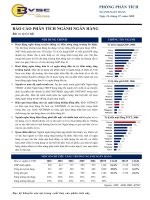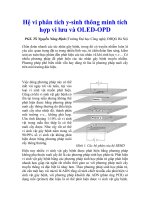PHÂN TÍCH POLYME (POLYMER ANALYSIS) pdf
Bạn đang xem bản rút gọn của tài liệu. Xem và tải ngay bản đầy đủ của tài liệu tại đây (2.63 MB, 108 trang )
TRƯỜNG ĐẠI HỌC BÁCH KHOA ĐÀNẴNG
KHOA HOÁ
PHÂN TÍCH POLYME
(POLYMER ANALYSIS)
TS. ĐoànThị Thu Loan
♣♣♣
üIs a branch of polymer science dealing with analysis and characterisation of
polymers.
üThe complication of macromolecular chains, the dispersion in molecular
weight, tacticity, crystallinity, orientation, composition of polymers etc. and
complex morphological systems
⇒ analysis of polymer ≠ the small organic materials
⇒ Focus on viscoelasticproperties, dynamic mechanical testing.
Polymer analysis
•Instronmechanical tester
•Vickerhardness tester
•DMA
•Melt flow indexer
•Torsions Rheometer
•
•-AFM, SEM
•-FT-IR
•-Pull-out test
Instruments
•FT-IR
•IR-microscope
•GPC ( size exclusion chromatography
SEC)
•-Viscosimetry
•-X-ray (WAXS and SAXS)
•-EM, SEM, TEM, AFM
•-Dynamic and static methods for contact
angle measurements.
-Tensile, flexural, impact,
compression, hardness tests,
-Rheologicaland viscoelastic
properties, stiffness and
modulus, surface tension,
permeation and diffusion in
polymers, adhesion tests,
density
-Surface roughness,
-Chemical
composition,
-Interface
characetrisation
-Molecular weight determination,
-Microstructuralcharacterisation and
compositional analysis,
-Crystallinity,
-Investigation of polymer morphology,
particle size,
-Contact angle and wettability
measurements
Mechanical and Physical
Properties
Surface
Characterisation
Chemical, Molecular and Structural
Characterisation
Methods of polymer analysis
•GC
•pH meter
•HPLC
•Karl-Fischer titration
•Thermogravimetricanalyser (TGA)
•TGA-FTIR coupled technique
•Differential scanning calorimetry(DSC)
•Modulated differential scanning
calorimetry(ADSC)
•Dynamic thermomechanicalanalyser
(DMTA)
•Dielectric relaxation
Instruments
Inolabconductivity
meter
•
Purity and molecular
weight of small
molecules, water content
in organic solvents,
surface tension
measurement, pH
-Melting point, glass transition
temperature, free rotation temperature,
-Degradation and stability behaviour of
polymers
Conductivity, electric
current in solution,
light emitting and
electromagnetic
properties
Miscellaneous (hontap)Thermal Behaviour
Electrical and Optical
Properties
Methods of polymer analysis
-For quality control
-For predicting service performance
-To generate design data
-To investigate failures
Purpose of polymer analysis
Essential to identify the purpose of testing, because the requirements for each
of the purposes are different.
-Precision
-Reproducibility
-Rapidity
Balance of these attributes,
according to the purpose of
the test
-Complexity
-Automated test
-Nondestructive test
-Cost
üNondestructive methods are advantageous and indeed essential when
100% of the output is being tested.
üThe tests should be simple and inexpensive, and automation will
probably aid the rapidity of testing.
üTests related to product performance are preferred.
Quality Control Tests
üThe most important factor is that the tests relate to service conditions
and to aspects of product performance.
üshould not be too complex, although rapidity and cheapness are less
important than was the case with quality control.
üNondestructive tests are not always appropriate when predicting product
performance, as it may be necessary to establish the point at which failure
occurs.
Tests Predicting Product Performance
üUsually test pieces are of a simple shape and a specified size, whereas
the product may be of a different geometry and size
üData must be presented in a form that enables the designer to allow for
changes in geometry, time scale, etc which implies detailed and
comprehensive understanding of material behavior
üIt follows that data of this type are expensive to produce and that results
are unlikely to be obtained with great rapidity.
üHowever, automation may be advantageous, particularly in the case of
tests running for a long time (creep tests)
Tests for Producing Design Data
üSome understanding of the various mechanisms of failure is necessary before
suitable tests can be chosen.
ü Tests need not be complex but must be relevant
Ex: a simple measurement of product thickness may establish thatthere has
been a departure from the specified design thickness.
üThe absolute accuracy of the test may not be important, but it is essential that
it be capable of discriminating between the good and the bad product.
Tests for Investigating Failures
What are our expectations of polymer materials?
•Excellent Characteristics:
Mechanical and Physical Properties
Thermal Behaviour
Surface and interface Characteristics
Electrical and Optical Properties
•Safe to use
•Light weight
•Reliable, durable
•Low cost
•Less adverse environmental impact
•Good resistance to environmental attacks
of Polymers
Types of MechnicalTests
Tensile test (a)
Flexural test (d) (e) (f)
Compression test (b) Shear (g)
(h)
(i)
Impact test (h) (i)
Scope:
üMeasure the force required to break a specimen and the extent to which the
specimen stretches or elongates to that breaking point.
üProduce a stress-strain diagram, which is used to determine tensile modulus.
üThe data is often used to specify a material, to design parts towithstand
application force and as a quality control check of materials.
üSince the physical properties of many materials (especially thermoplastics) can
vary depending on ambient temperature ⇒ test materials at temperatures that
simulate the intended end use environment.
Tensile test
Specimen Size:
üThe most common specimen for ISO 527 is the ISO 3167 Type 1A
multipurpose specimen.
üASTM D882 uses strips cut from thin sheet or film.
*The multipurpose test specimen:
+150 mm long,
+The centersection: 10 mm wide *4 mm thick *80 mm long.
Tensile test
A tensile dog bone specimen
b
W
l
δ
For the composite samples
Longitudinal test
Transverse test
Test Procedure:
üSpecimens are placed in the
grips and pulled until failure.
üFor ASTM D638, the test
speed is determined by the
material specification.
üFor ISO 527 the test speed
is typically 5 or 50mm/min for
measuring strength and
elongation
+and 1mm/min for measuring
modulus.
ü An extensometer is used to
determine elongation and
tensile modulus.
Tensile test
Tensile2.wmv
Characteristics of stress-strain behavior:
ü Modulus of elasticity (stiffness, elastic
modulus, Young’s modulus) is the slope of
the stress-strain curve in the elastic region
ü Yield strength (σ
y
)is the stress applied to a
material that just causes permanent
deformation
ü Tensile strength (TS) is defined at the
fracture point and can be lower than the
yield strength
ü Ultimate tensile strength is the stress that
corresponds to the maximum load
ü Elongation at break (%ε) –the increase in
length of a specimen under tension before
it breaks (Strain).
Stress –Strain Behavior
P= Applied load
A = Original cross-sectional area
Strain, ε
Stress, σ
σ
y
ε
y
ε
F
σ
F
2%
0
•
E
= δ/l
Stress –Strain Behavior
üModuliof elasticity for polymers are ~ 10MPa-4GPa (compare to metals ~ 50 -
400 GPa)
üTensile strengths are ~ 10 -100MPa (compare to metals, hundreds of MPato
several GPa)
üElongation can be up to 1000 % in some cases (< 100% for metals)
üPolymers are also very sensitive to the rate of deformation (strain rate).
Decreasing rate of deformation has the same effect as increasingT.
Stress –Strain Behavior
TENSILE RESPONSE: ELASTOMER CASE
Deformation of Amorphous Polymers









